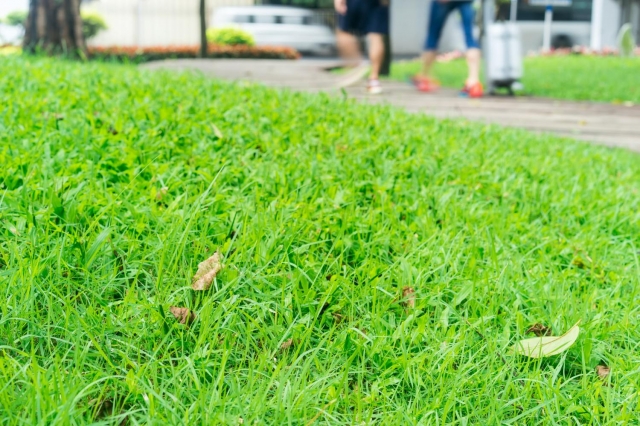Have you ever looked at your lawn and wondered if there’s a greener, more sustainable way to bring it back to life?
Lawns are a staple in many American homes. They offer a place to relax, play, and gather. But keeping a lawn lush and healthy often means high water bills, chemical fertilizers, and constant upkeep. The good news is there are eco-friendly methods to repair and renew your lawn without harming the environment. These methods focus on soil health, efficient water use, and natural solutions that support long-term growth.
In this article, we’ll explore eco-friendly lawn care practices that help you repair damage, revive thinning grass, and prevent future problems. Whether your lawn suffers from bare patches, weeds, or poor soil, you can use these strategies to restore it naturally.
Understanding the Root of Lawn Problems
Before starting any repair, it’s important to know why your lawn is struggling. Common problems include compacted soil, poor drainage, overuse of chemicals, and inconsistent watering. In many cases, lawns decline because the soil ecosystem is out of balance. Healthy soil should hold moisture, allow roots to spread, and provide natural nutrients.
By identifying the root cause, you avoid quick fixes that only mask the problem. Instead, you create a plan that works with nature.
Improve Soil Health Naturally
Healthy soil is the foundation of a thriving lawn. Instead of relying on chemical fertilizers, focus on building organic matter. Compost, grass clippings, and shredded leaves add nutrients and improve soil texture. Microbes and earthworms thrive in this environment, making the soil more fertile and resilient.
Aeration also helps. By loosening compacted soil, you allow water, oxygen, and nutrients to reach the roots. Manual or mechanical aerators create small holes across the yard, giving roots the space they need to expand.
Use Smart Watering Techniques
Traditional lawn care often wastes water. Sprinklers that run too long or at the wrong time cause runoff and shallow roots. Eco-friendly watering focuses on efficiency.
- Water deeply but less often. This encourages roots to grow deeper.
- Water early in the morning. Less water evaporates compared to midday.
- Install drip irrigation or soaker hoses. These systems target roots directly.
By saving water, you reduce costs and help your lawn build natural resilience to drought.
Choose the Right Grass for Your Region
Not all grasses are equal. Some thrive in hot climates, while others prefer cooler temperatures. Choosing a grass suited to your region reduces the need for extra water and chemicals. Native and drought-tolerant varieties are excellent eco-friendly options.
If you’re repairing large areas, consider alternatives like bermudagrass sod in warmer regions. It establishes quickly, tolerates heat, and needs less water once mature. For cooler areas, ryegrass or fescue may be a better fit.
Repair Bare Patches with Grass Plugs
One of the most eco-friendly ways to restore bare spots is by using grass plugs. These are small sections of live grass that you plant directly into the soil. Unlike reseeding, plugs already have established roots, so they grow faster and are more resistant to weeds.
Plugs are also cost-effective compared to laying new sod. They gradually spread and fill in empty spaces, creating a uniform lawn over time. This method requires less water and fewer resources, making it a sustainable choice.
Mulch and Compost for Long-Term Growth
Instead of discarding yard waste, recycle it into mulch or compost. Mulch helps regulate soil temperature, retain moisture, and suppress weeds. Compost, on the other hand, boosts soil fertility and reduces the need for synthetic fertilizers.
Applying a thin layer of compost over your lawn once or twice a year improves soil structure and feeds beneficial organisms. Over time, your lawn becomes greener and healthier without chemical inputs.
Natural Weed Control
Weeds often take over lawns that lack strong, healthy grass. Instead of chemical herbicides, use eco-friendly methods:
- Hand-pull weeds when the soil is moist.
- Overseed thin areas to crowd out weeds naturally.
- Use vinegar or boiling water on tough spots.
By strengthening your grass and soil, you reduce the conditions that weeds thrive in. Prevention is always easier than control.
How to Revive Dead Grass Without Chemicals
Sometimes, sections of the lawn look beyond saving. Instead of replacing everything, focus on how to revive dead grass naturally. Start by raking away debris and aerating the area. Apply compost to restore nutrients, then reseed or plant plugs in bare spots.
Consistent watering during the first few weeks helps the grass establish. With time, even severely damaged lawns can bounce back without chemical intervention.
Reduce Mowing Frequency
Mowing less often saves energy and benefits your lawn. When grass is cut too short, it becomes stressed and more vulnerable to weeds and drought. By keeping grass slightly taller, you promote deeper roots and natural shade for the soil.
Consider leaving clippings on the lawn instead of bagging them. They decompose quickly and return nutrients to the soil.
Eco-Friendly Lawn Alternatives
If your lawn requires constant attention, think about reducing its size. Replace some areas with native plants, ground covers, or a wildflower patch. These options need less water, attract pollinators, and add diversity to your yard. Gravel paths and garden beds can also cut down on lawn space while improving curb appeal.
Seasonal Maintenance Tips
Every season brings new challenges for lawns. Adapting your care routine keeps your lawn healthy year-round:
- Spring: Aerate, overseed, and apply compost.
- Summer: Water deeply, mow higher, and manage weeds.
- Fall: Reseed thin areas and add mulch.
- Winter: Limit foot traffic and prepare tools for spring.
By working with the seasons, you create a sustainable cycle that supports lawn growth naturally.
Conclusion
Repairing and renewing your lawn doesn’t have to rely on chemicals, wasteful watering, or endless maintenance. By focusing on soil health, efficient watering, natural weed control, and sustainable planting methods, you can create a vibrant lawn that benefits both your home and the environment.
From using compost and mulch to choosing the right grass type and repairing patches with plugs, eco-friendly practices save resources and deliver lasting results. Even severely damaged areas can bounce back when given the right care and attention.
The eco-friendly way is not only better for the planet but also for your wallet and your family’s health. With these methods, your lawn can thrive naturally, offering a green, inviting space for years to come.






